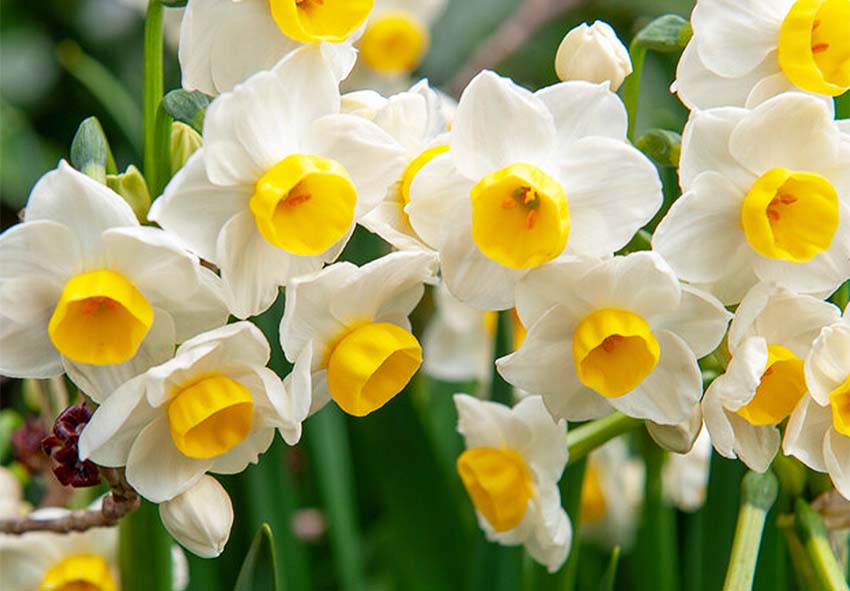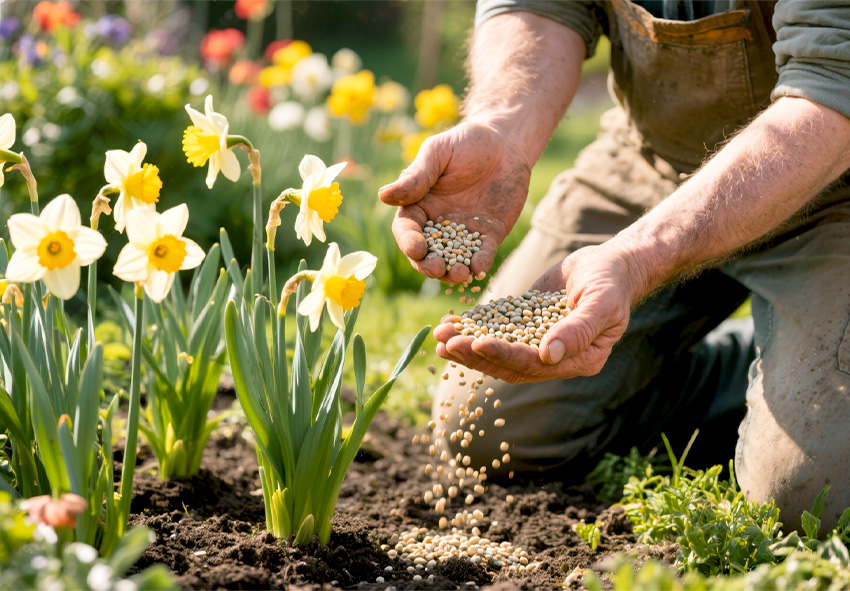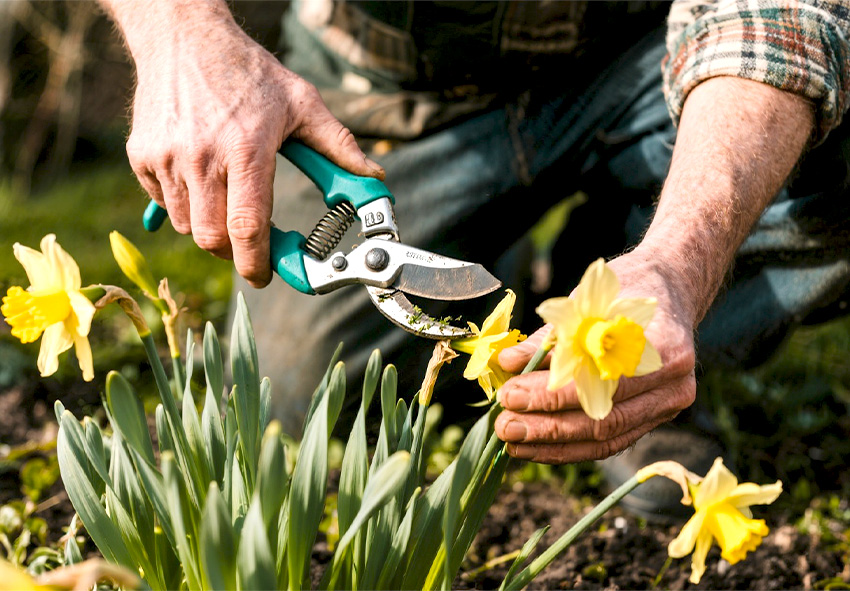Daffodils are among the most beloved spring flowers, bringing cheerful color to gardens after a long winter. Their bright yellow, white, or bi-colored blooms signal the start of the growing season and are a staple in many landscapes. Year-round care for daffodils ensures that bulbs remain healthy, produce abundant flowers, and naturalize beautifully over time. In this guide, we’ll cover everything from planting daffodils to seasonal maintenance, helping you enjoy their beauty for years to come. Our gardening blog is a perfect place to find all the information about daffodils and other plants you need!
Understanding Daffodils

Daffodils (Narcissus) are hardy, low-maintenance perennials that thrive in many climates. They’re valued for their long blooming period, deer resistance, and ability to multiply naturally in the garden. Knowing the basics of daffodil growth is essential for providing the right care. By understanding their growing cycle and unique needs, you can keep them healthy and vibrant season after season.
About Daffodils
Daffodils are bulbous plants that bloom in early to mid-spring. They come in various shapes, sizes, and colors, often with a trumpet-shaped corona surrounded by petal-like tepals. Their hardiness makes them an excellent choice for both beginner and experienced gardeners. They are also easy to naturalize, meaning they return year after year with minimal intervention.
Popular Daffodil Varieties
Daffodils come in a wide range of colors, shapes, and bloom times, making them a versatile choice for any garden. Choosing the right variety can enhance your landscape and extend the flowering season. From classic yellow trumpets to unique multi-colored blooms, there are daffodils for every style and preference:
- King Alfred – A classic large yellow trumpet daffodil, known for its bold presence in early spring gardens.
- Ice Follies – Features white petals and a soft yellow cup that fades to creamy white, perfect for brightening borders.
- Tête-à-Tête – A charming miniature variety that works beautifully in containers or small garden spaces.
- Pink Charm – White petals with a blush-pink trumpet, adding a delicate touch to spring displays.
- Dutch Master – A reliable and vigorous yellow daffodil that produces abundant blooms year after year.
Lifespan and Growth Cycle
Daffodils follow a simple life cycle: dormancy, leaf growth, flowering, and post-bloom energy storage. The green leaves after flowering are crucial, as they photosynthesize and feed the bulb for next year’s flowers. Cutting foliage too soon can weaken the bulb and reduce blooms the following spring. Understanding this cycle helps you time your care tasks effectively.
Spring Daffodil Care
Spring is the most rewarding time for daffodil growers. Blooms emerge, and proper care during this period ensures a strong display. This is also the best time to assess plant health and make small adjustments to care routines.
- Watering During Bloom: Daffodils prefer evenly moist soil while flowering. Water during dry spells, but avoid overwatering, which can cause bulb rot. Focus on watering at the base rather than wetting leaves to reduce disease risk. Consistent moisture supports vibrant blooms and healthy foliage.
- Feeding for Healthy Blooms: Apply a balanced, slow-release fertilizer when shoots first appear. This boosts flower production and strengthens bulbs for the next season. Avoid high-nitrogen fertilizers, which promote leaf growth at the expense of flowers. Feeding at the right time is key to maintaining strong bulbs.
- Deadheading Spent Flowers: Remove faded blooms to prevent seed production. This redirects the plant’s energy into the bulb, ensuring better blooms next year. Use clean, sharp scissors or pruners to avoid damaging the stem. Leave the foliage intact for several weeks after blooming.
Summer Daffodil Maintenance

Once flowers fade, daffodils begin storing energy for next season’s blooms. This is a critical time for bulb health. Summer care is mostly about letting nature take its course while avoiding unnecessary interference.
Foliage Management
Leave leaves in place until they turn yellow and wilt naturally. Cutting them too soon can weaken the bulb. If the appearance bothers you, plant companion perennials to hide the fading foliage. This also helps keep your garden looking fresh.
Pest and Disease Checks
Inspect bulbs for signs of rot, aphids, or fungal spots. Treat issues early to prevent spread. Removing any diseased foliage promptly can help stop problems from reaching the bulb. Healthy summer foliage is an indicator of a strong next season.
Autumn Preparations for Daffodils
Autumn is the perfect time not only for planting daffodils, but also for rejuvenating daffodil beds. The weather is cooler, and plants are entering dormancy. This is your chance to reset the stage for spring blooms.
Dividing and Replanting Bulbs
Every 3–5 years, dig up crowded bulbs after foliage dies back and replant them in fresh soil. This prevents overcrowding and promotes healthier blooms. Dividing also helps you propagate daffodils to new garden areas. Always replant bulbs at the correct depth for best results.
Soil Improvement Before Winter
Mix in compost or well-rotted manure to enrich the soil before cold weather sets in. Healthy soil supports strong root growth during dormancy. Adding organic matter also improves drainage and soil texture. Preparing soil now pays off in spring.
Winter Daffodil Care
Even though daffodils are dormant in winter, they still benefit from seasonal protection. Harsh winter conditions can damage bulbs if not properly insulated. A little attention now ensures they survive until spring.
Mulching for Cold Protection
Apply a 2–3 inch mulch layer to shield bulbs from extreme cold and temperature fluctuations. Mulch also prevents frost heaving, which can expose bulbs to air and cause damage. Use straw, shredded leaves, or pine needles for best results.
Container Daffodil Protection
Move potted daffodils to sheltered spots or insulate pots to prevent freezing. Containers are more vulnerable to temperature swings than garden beds. Wrapping pots in burlap or bubble wrap can add extra protection.
Common Mistakes in Daffodil Care

Even though daffodils are generally low-maintenance, certain errors can impact their bloom quality and overall health. Avoiding these pitfalls will help your plants thrive year after year. By understanding common mistakes, you can take proactive steps to keep your daffodils looking their best each spring:
- Cutting Foliage Too Early – Removing leaves before they yellow naturally deprives bulbs of stored energy for the next season.
- Overwatering – Excess moisture, especially in poorly drained soil, can cause bulbs to rot.
- Planting Too Shallow or Too Deep – Incorrect planting depth can hinder root development or expose bulbs to weather damage.
- Neglecting Bulb Division – Overcrowded bulbs compete for nutrients, leading to fewer and smaller blooms.
- Ignoring Pest or Disease Signs – Delaying treatment for aphids, fungal infections, or bulb rot can cause long-term damage.
Conclusion
With proper year-round care, daffodils will return each spring with vibrant, healthy blooms. Following seasonal maintenance routines ensures that your bulbs remain strong, disease-free, and capable of multiplying for years of enjoyment. Consistency is key — the better you care for your daffodils now, the more stunning your garden will be in the future!
Frequently Asked Questions (FAQs) about Care for Daffodils
1. How often should I water daffodils during the growing season?
Daffodils prefer consistent moisture during their active growth in spring. Water deeply once a week if rainfall is lacking, ensuring the soil remains moist but not soggy. After blooming, reduce watering as the foliage begins to yellow, allowing the bulbs to enter dormancy naturally without rotting.
2. When is the best time to plant daffodil bulbs?
The ideal time to plant daffodil bulbs is in the fall, about 2–4 weeks before the ground freezes. This allows them to establish roots before winter. Planting too early can cause premature sprouting, while planting too late may not give the bulbs enough time to prepare for spring blooms.
3. Can I order Dutch daffodil bulbs from your online store?
Yes, of course! Check our store Dutch-bulbs.com for availability and enjoy the convenience of having top-quality daffodil bulbs delivered to your doorstep, ready for planting in the fall. Ordering from us ensures you receive high-quality bulbs that have been stored and handled with care.
4. How should I care for daffodils after they bloom?
After blooming, deadhead the flowers but leave the foliage in place until it turns yellow. This allows the leaves to photosynthesize and store energy in the bulbs for next year’s blooms. Avoid cutting back greenery too soon, as this can weaken the plant and reduce future flowering.
5. Do daffodils need fertilizer?
Yes, daffodils benefit from fertilization to support strong blooms and healthy bulbs. Apply a balanced, slow-release bulb fertilizer in early spring as shoots appear. A second light feeding after blooming can also help replenish nutrients, ensuring the bulbs remain vigorous for the following year’s flowering cycle.
Published: 19.08.2025
